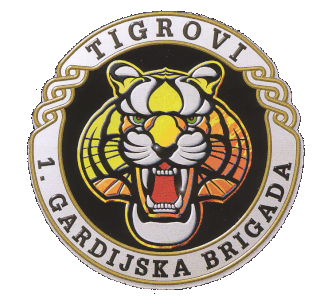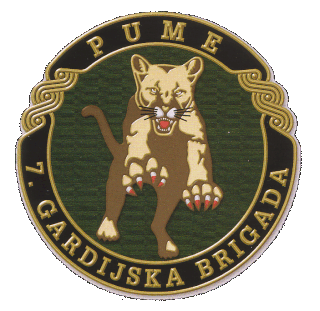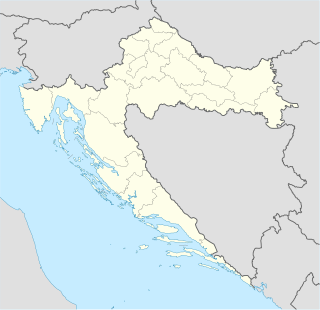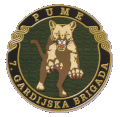
The Croatian Army and Croatian Ground Army is the largest and most significant component of the Croatian Armed Forces (CAF).
The 104th Brigade was a unit of the Croatian Army that existed during the Croatian War of Independence.

The 1st Armoured Infantry Brigade is an infantry brigade of the British Army with a long history including service during both the First and the Second World Wars. It is based at Tidworth Camp. Previously, it has been designated 1st (Guards) Brigade, 1st Infantry Brigade, 1st Mechanised Brigade, and under the initial Army 2020 reforms assumed the title of 1st Armoured Infantry Brigade. Under the Future Soldier programme, the brigade will merge with 1st Artillery Brigade to form 1st Deep Recce Strike Brigade Combat Team.

Colchester Garrison is a major garrison located in Colchester in the county of Essex, Eastern England. It has been an important military base since the Roman era. The first permanent military garrison in Colchester was established by Legio XX Valeria Victrix in AD 43 following the Roman conquest of Britain. Colchester was an important garrison town during the Napoleonic Wars and throughout the Victorian era. During the First World War several battalions of Kitchener's Army were trained there. Now, 2nd Battalion and 3rd Battalion of The Parachute Regiment are based there. Today there are new barracks, which, in replacing the Victorian buildings, have made available building land slightly nearer the town centre.

Croatia's First Mechanized Guard Brigade - named "The Tigers" - was the most elite and best equipped military brigade of the Croatian Army. Its military base and headquarters was in the Croatian capital of Zagreb, origin of most of the brigade's personnel. In 2008, as part of a larger military restructuring, the brigade-sized unit was disbanded and reformed as a battalion of the Motorized Guard Brigade.

The Battle of the Barracks was a series of engagements that occurred in mid-to-late 1991 between the Croatian National Guard and the Croatian police on one side and the Yugoslav People's Army (JNA) on the other. The battle took place around numerous JNA posts in Croatia, starting when Croatian forces blockaded the JNA barracks, weapons storage depots and other facilities. It formally began on 14 September; its objective was to neutralise the JNA positions in ZNG-held territory and to secure arms and ammunition supplies for the poorly equipped ZNG.

The Skaraborg Regiment, designation P 4, is a Swedish Army armoured regiment that traces its origins back to the 16th century. It was converted from an infantry regiment in 1942. The regiment's soldiers were originally recruited from Skaraborg County, and it is currently garrisoned in Skövde, in former Skaraborg County.

The Royal Croatian Home Guard was the Croatian-Slavonian army section of the Royal Hungarian Landwehr, which existed from 1868 to 1918. The force was created by decree of the Croatian Parliament on December 5, 1868 as a result of the Croatian–Hungarian Settlement.

The 7th Guards Brigade, also known by their nickname Pumas, was a Croatian Ground Army (HV) brigade formed on 23 December 1992 in Varaždin. The brigade was initially formed out of the 5th Battalion of the 1st "Tigers" Brigade and its first commander was Ivan Korade, who led the unit during the War of Independence (1991–95).

The 2nd Guards Brigade, also known by their nickname Thunders (Gromovi), was one of the original Croatian National Guard (ZNG) brigades formed in 1991 and one of the most elite mechanized infantry units in the Croatian Ground Army (HV) during its existence, during which it saw action in a number of engagements during the War of Independence (1991–1995).

Guards Armoured Mechanized Brigade is a mechanized infantry brigade of the Croatian Army based in Vinkovci, Eastern Croatia. The Guards Armoured Mechanized Brigade is the largest tactical unit of the Croatian Army and is commanded by Brigadier General Mijo Validžić.

The Guards Mechanized Brigade is one of the two main tactical components of the Croatian Army. The brigade is based in southern Croatia with main headquarters in Knin.

The Battle of Logorište was fought east of Duga Resa and south of Karlovac, Croatia, from 4–6 November 1991 during the Croatian War of Independence, between the Croatian National Guard and the Yugoslav People's Army. The ZNG placed the JNA-held Logorište barracks under a blockade as part of the countrywide Battle of the Barracks, which aimed to pin down JNA units isolated in their bases and force them to surrender weapons and ammunition to the ZNG. However, the JNA garrison broke out from the besieged barracks with part of its stored equipment before the ZNG claimed the vacant base. The breakout was supported by JNA units and SAO Krajina units deployed to lift the blockade of the barracks and other JNA garrisons in Karlovac. A battle ensued as the ZNG attempted to contain advancing JNA units, ending with a ceasefire signed in The Hague.

The siege of Varaždin Barracks, also referred to locally as Varaždin's days of war, was the blockade and capture of the Yugoslav People's Army (JNA) barracks and other facilities in and around the city of Varaždin during the Croatian War of Independence. The blockade began on 14 September 1991, quickly escalated into fighting, and ended on 22 September with the surrender of the JNA garrison. It was part of the Battle of the Barracks—an effort by Croatian armed forces to isolate JNA units based at barracks in Croatia, or capture the barracks to provide arms for Croatia's nascent army.

The siege of Bjelovar Barracks, also known by the codename Operation Bilogora, was the blockade and capture of the Yugoslav People's Army (JNA) barracks and other facilities in and around the city of Bjelovar, a part of the JNA 32nd (Varaždin) Corps, during the Croatian War of Independence. A general blockade of the JNA facilities in Croatia was ordered on 14 September 1991, and it continued until 29 September when the JNA garrison was captured by Croatian forces. Its capture occurred one week after the bulk of the 32nd Corps surrendered. It was part of the Battle of the Barracks—an effort by Croatian armed forces to isolate JNA units based at barracks in Croatia, or capture the barracks to provide arms for Croatia's nascent army.

The structure of the British Army of the United Kingdom (UK) will be reorganised in 2022 with the Future Soldier reform. The British Army is commanded by the Chief of the General Staff (CGS), with Army Headquarters which is located in Andover, Hampshire. Subordinate to that post, there is a Commander Field Army, and a personnel and UK operations command, Home Command.
Enhanced Forward Presence (EFP) is a NATO-allied forward-deployed defense and deterrence military force in Central and Northern Europe. This posture in Central Europe through Poland and Northern Europe through Estonia, Latvia, and Lithuania, is in place in order to protect and reassure the security of NATO's Central and Northern European member states on NATO's eastern flank. Following Russia's invasion of Crimea, NATO's member states agreed at the 2016 Warsaw summit to forward deploy four multinational battalion battle groups to areas most likely to get attacked.
The 1st Mechanized Battalion "Sokolovi" is one of two mechanized infantry battalions within the Guards Armoured Mechanized Brigade (GOMBR) of the Croatian Army.
Tank Battalion "Kune" is one to two armoured units within the Guards Armoured Mechanized Brigade (GOMBR) of the Croatian Army.

The Ranger Regiment is a special operations-capable unit of the British Army which was formed on 1 December 2021 under the Future Soldier reform and is part of the Army Special Operations Brigade. It is intended to be used primarily in an unconventional warfare and foreign internal defence capacity in a similar manner to the US Green Berets.















